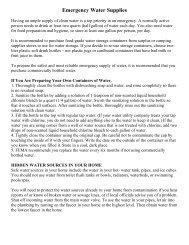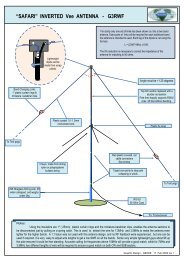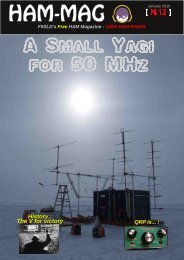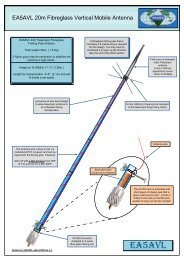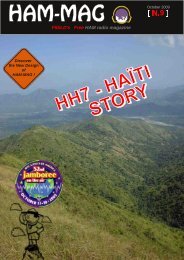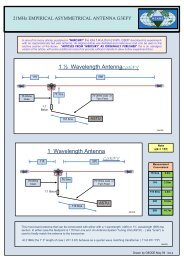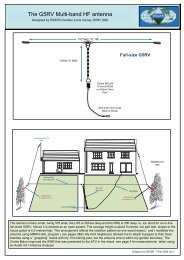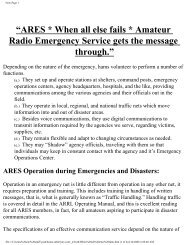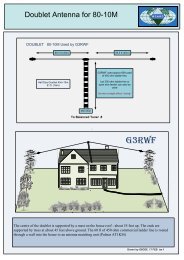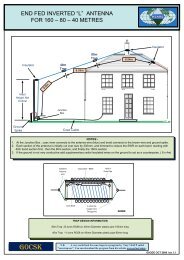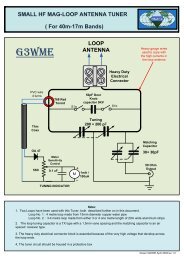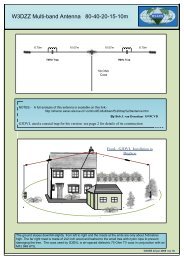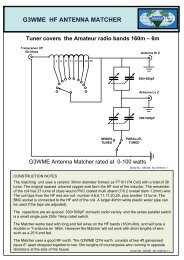Inernational HAM Magazine 100% HAM RADIO - arkansas ares races
Inernational HAM Magazine 100% HAM RADIO - arkansas ares races
Inernational HAM Magazine 100% HAM RADIO - arkansas ares races
You also want an ePaper? Increase the reach of your titles
YUMPU automatically turns print PDFs into web optimized ePapers that Google loves.
While Jodrell Bank invested 1.6 million sterling pounds ($2.3 millions of 2000) to track satellites, that<br />
USAF spent 15 millions dollars at Tyngsboro, Mass., to build his Haystack radar (used later by NASA in<br />
his Orbital Debris Radar Calibration System ODERACS), and that a Turino industrial built a parabolic<br />
dish at 2 millions lira ($900), our two young amateurs had only 18,000 lira or a little more than $8 to<br />
spend. So the only solution was to build themselves their equipment.<br />
With an extraordinary ingenuity they achieved their objective in a couple of years and were able to track<br />
any satellite passing nearby since the first Sputnik. In 1965 they created the Zeus network that counted<br />
17 stations spread over the world and hooked by shortwaves. Their installation was so sophisticated<br />
that there were able to forecast 12 hours ahead that Lunik IV launched by Russian to the Moon should<br />
miss its target by 8000 km (5000 miles). In fact it flew 8497 km off the Moon.<br />
Sketch showing a sixdipole array used at Torre bert.<br />
To pick up these messages Torre Bert used up to 21 antennas. The<br />
one displayed at left is a sixdipole array that could be tuned on 108,<br />
137, 145.8 or 405 MHz. They used also a single helical antenna placed<br />
at center of the large ground plane. It was controlled manually using a<br />
wheel installed in the tracking room. This antenna system offered a 7.8<br />
dB gain over a single Yagi. This gain was so low that even the Gian<br />
Battista JudicaCordiglia considered this system as unsuited or almost<br />
to pick up space communications as it was often at the limit of the<br />
background noise. But we will see in a moment that these frequencies<br />
hide other mysteries.During its short existence, it seems that Torre Bert<br />
recorded some sensational messages from space. But not everybody share this opinion, and<br />
personally, even having not had the opportunity to listen all tapes, some technical objections can<br />
already be presented. Here are some examples of recordings made by Torre Bert, beginning with the<br />
most famous of them, a recording of John Glenn made in 1964.<br />
If by some ways the Torre Bert installation displayed some attracting but useless devices (display and<br />
vector maps) or had to manually rotate their antenna, the JudicaCordiglia brothers had the right<br />
telemetry receivers, the suited antennas and, last but not least, the knowhow to build a functionning<br />
receive space communication station. Here is an example of their skills.<br />
In 1964, they won a TVgame dealing with the space conquest and were rewarded in receiving a gift of<br />
1,8 millions lira (about $830 of 2000). Our young Turino brothers took advantage of this opportunity to<br />
visit the USA. It was written that they had the support of the U.S. Embassy in Roma, thanks to the help<br />
of their Scientific Attaché Mr Walter Ramberg who organized for them a meetings with some NASA<br />
specialists of space communications, including M.Haussman, in presence of an italianse/american<br />
translator named Alberto Rossoto. According to some writers and a film recently released on european<br />
TV, this is at this occasion that the two brothers visited NASA space centers of Huntsville, Cape<br />
Canaveral, Houston and Beltsville where they did the admiration of American engineers by the extent of<br />
their knowhow. They played tapes they had made of John Glenn's conversations with Capcom<br />
recorded during the Friendship 7 mission of 1962.<br />
According to various sources, Haussman and other NASA officials were astounded. Harry J. Goett,<br />
director of the Goddard Space Flight Center said to their translator that "They have done a remarkable<br />
job" but was afraid that amateurs were able to discover secret working frequencies. NASA never<br />
announces the audio frequencies while the spaceflight is not ended, for fear of causing jam on<br />
frequencies or other problems. They thus asked to the youngs how they determined this special<br />
frequency in the Lband. "Easy", the JudicaCordiglias said, "we saw a preflight picture of the Glenn<br />
capsule and we figured the frequency from the size of the capsule's antenna !...".<br />
Note for the anecdote, that convinced that NASA was subjugated by the knowhow of our two brothers,<br />
these latter requested to NASA the permission to get two of their secret space frequencies in exchange<br />
of what our two brothers would give them two space frequencies used by Russia. Of course, NASA<br />
engineers accepted the deal and give them what they asked, at the greatest pleasure of our two<br />
brothers.<br />
[ <strong>HAM</strong>MAG N.14 March 2010 ]



